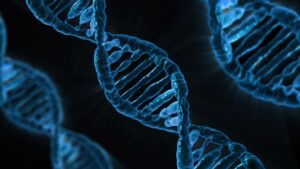
Why is the study of the origins of life so difficult and perplexing? One reason is that it took place a long time ago — more than 3.5 billion years. Second, the planetary conditions on ancient Earth may have been dramatically different than now, making questionable any inferences we draw from the present. Third, we’re only familiar with the history of life on one planet, so we don’t even know whether life is an extremely rare or common phenomenon in the Universe.
The Origins of Life and Human Identity
Given these challenges, one might wonder why we trouble ourselves with such an immensely difficult question. The fact that we struggle with it says a lot about ourselves. Humans are not satisfied simply to be fed, clothed, and sheltered. Regardless of one’s worldview, we all want to know something about where we come from, who we are, and where we are headed. Questions about the origins of life are not merely a matter of curiosity, but of human identity. Are we alone in the Universe? How did we get here? What can the past tell us about the present and future of life on Earth? Professor Sara Walker, astrobiologist and grantee of the John Templeton Foundation, discusses these profound questions surrounding the nature and origins of life in the video below.
If we think that the very earliest life was dramatically different from what we can infer from present organisms, then one could start from chemistry and work forwards through time. The upside of this approach is that it is not constrained by the conditions of the present Earth and the organisms that happen to be alive now. On the downside, how do you discern from the vast set of possibilities what ancient Earth conditions could have been? To be successful, this approach depends on an accurate understanding of primitive Earth and Solar System environments, drawing heavily from planetary science, geosciences, and chemistry. The holy grail would be to find a simple, self-replicating chemical system that could complexify over time.
Whether one takes a forward- or backward-looking approach requires dramatically different scientific skill sets, which makes origins of life research a sprawling, multi-disciplinary endeavor that no one person can completely master. Will thousands of specialists, each working in their own domain, ultimately be able to provide a unified picture of life’s origins? No one knows at this point — that’s part of what makes science so exciting (and unpredictable).
What ingredients do you need to produce life?
In addition to the quest to pinpoint when life originated, it is equally exciting to explore how life originated. Think of it this way — if you were going to build a simple, self-sustaining, self-replicating machine, what would your list of parts include? Nature started this process over 3 billion years ago, resulting in the vast diversity of life that we see today. But when you look more closely, you see that the same basic ingredients comprise every living thing: proteins, fats, sugars, and nucleic acids.

These four ingredients, combined with a few other things like vitamins and minerals, are the foundation of life on Earth. Of course, this begs the question, how did these molecules come into existence in the absence of any organisms to manufacture them? This is a mystery that has flummoxed scientists for well over a century, and it has inspired the development of a field called prebiotic (“before life”) chemistry.
Prebiotic chemistry attempts to not only produce the ingredients that could have been used to assemble the first living organisms, but also to explain the self-assembly of the first living organisms. For many researchers, the goal of prebiotic chemistry is the assembly of a simple living system with some of the common attributes of modern cells, such as a lipid membrane, RNA and/or DNA, and small protein-like peptides.
The Future of Origins of Life Studies
Given adequate expertise and experimental conditions, it is possible to synthesize almost any organic molecule in the laboratory under simulated prebiotic conditions. The wide range of experimental conditions under which organic compounds can be formed also demonstrates that organic compounds are prebiotically “robust,” making it more likely that life could arise, both on Earth and elsewhere. However, the fact that molecular components of contemporary cells can be formed in the laboratory does not tell us which ones were essential for the origin of life, or that they existed in the prebiotic era.
Although our ideas on the prebiotic synthesis of organic compounds are based largely on experiments in model systems, this type of chemistry is supported by the occurrence of diverse organic compounds in meteorites and comets, as well as elsewhere in the Solar System. It is therefore plausible, but not proven, that similar events took place on the primitive Earth. For all the uncertainties surrounding the emergence of life, it appears that the formation of a “prebiotic soup” is one of the most firmly established aspects of the primitive Earth, though its recipe remains difficult to decipher.
A comprehensive understanding of how prebiotic chemicals assembled into stable, self-replicating cells on primitive Earth remains elusive for now, despite considerable progress in chemistry, molecular biology, Earth sciences, planetary sciences, astronomy, and the search for extraterrestrial life. But with the frontiers of science expanding rapidly in each of these areas, we are in store for many exciting and surprising discoveries.
Still Curious?
Read the full research review on The Origins of Life written by Professor H James Cleaves of the Earth-Life Science Institute at the Tokyo Institute of Technology.
Explore additional research on the origins of life:
Discover our other research reviews on discoveries. Explore topics such as:

